The Traditional Māori Boil-up is easy and delicious
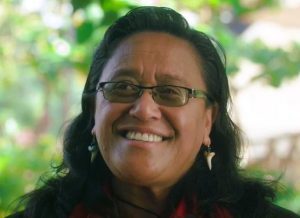
Rahira “La” Makekau
The Polynesian Cultural Center is pleased to share this traditional Māori Boil-up recipe provided by Rahira Makekau who is the Māori Cultural Performance Specialist and Advisor for the Center. Māori are people of Polynesian descent who came from Aotearoa which translates to the “Land of the Long White Cloud”. You may know it as New Zealand.
Rahira was born and raised in Aotearoa. It was there that she met her husband of 32 years, Kim Makekau, who is from Hawaiʻi. Together they raised a family of 5 children. She moved with Kim to the island of Oʻahu in 2006 to honor her heritage through working at the Polynesian Cultural Center, where she has worked for the past 17 years.
The History of the Māori Cuisine
Quote: “Our indigenous Māori people were traditionally hunters, gatherers and crop farmers, who harvested food from forest, stream, sea and garden. Not surprising then that the ingredients that make it to our plates come from these sources.
How to use a Hāngī
“As you move from one Māori iwi (tribe) to the next, ingredients and preparation style vary – driven purely by what is available close by. Freshness and natural flavors form the very essence of Māori cooking. Today, not only are Māori ingredients used in traditional style cooking such as a Hāngī, but also found in food that is prepared for the modern palate.”
Kai Māori – Te Ara Encyclopedia of New Zealand
One of the regional influences on Māori cuisine comes from the fact that their lands, especially around Rotorua, are dotted with hot springs:
The geothermal region around Rotorua supplied endless boiling water and super-heated steam for cooking. These 1901 photos show residents of Whakarewarewa village cooking by two methods. Those on the left boil food by suspending it in baskets lowered into a hot pool on cords. On the right, a hāngī has been cooked by digging a hole in the earth and steaming the food with geothermal heat. Both methods are still used in this region.
Cooking food in hot springs, 1901 – Māori foods – kai Māori – Te Ara Encyclopedia of New Zealand
The significance of a traditional “Boil-up”
“The humble Boil-up is a staple in ….. I’m going to say it … all Māori homes, no matter where in the world we find ourselves living”, Rahira shared. “All whānau (family) have their preferences when it comes to how to make a ‘good/proper’ Boil-up, but all Boil-ups have the same basic ingredients… meat, root vegetables and greens.”
“Growing up, our Boil-ups mainly consisted of pork bones, bacon bones (cheap but heaps of meat on the bones), mutton or whatever other meat was on special, Watercress and Puha (Sow Thistles … which aren’t actually thistles.) Mum often added silverbeet, turnip tops or spinach to make it go further. We loved all variations of Mum’s Boil-up. During all my pregnancies I craved Mum’s Boil-up. They comforted me, made me happy, and for some reason they were extra reka (sweet/delicious).”
“ I know it is a poor man’s meal, but looking back I see it was much more than that, it was comfort, safety and family in every serving …. my ultimate comfort food.
“Please check out this link. It just made me smile. I felt as though she was talking about my family The Politics of Boil Up (debatemag.com)”.
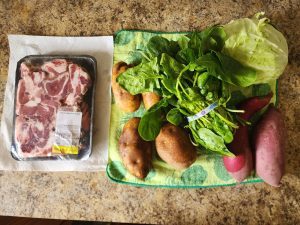
The typical ingredients for a simple Boil-up
A review of traditional and alternative “Boil-up” ingredients
Meat – Your preference. I’m partial to neck chops or pork bones, but any meat that can be boiled is great. Here in Hawaiʻi I usually use pork strips or even pork back ribs. I just cut them up and it’s like having pork bones.
Silver-side (corned beef) is also good, but cook it whole and slice it when you’re ready to eat.
Root vegetables – I always have potatoes and kumara (our variation of sweet-potato) in my Boil-up. Sometimes I use pumpkin, less often carrots. Another popular addition is watercress.
Greens – These days I generally use cabbage. I sometimes add spinach (to trick myself into thinking it’s puha, hahaha).
Doughboys (dumplings) – A family favorite!!

The finished product
Recipe for Māori “Boil-up”
For whānau (family) of 6
Ingredients
– Pork – 1 – 2 pks of soft bone ribs, or any meat as mentioned above
– Potatoes – 6 to 8 small potatoes
– Cabbage – 1
– Kumara – 1 big or 2 medium
Note: There is a specific type of Kumara we get in NZ. It’s red on the outside, but white on the inside. When it’s cooked it turns yellow.
– Salt to taste
Doughboys
– 3 cups flour
Note: You can substitute with self-rising flour, simply leave out the baking powder
– 3 tsp baking powder
– dash of salt
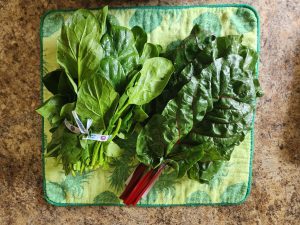
A popular green in Aotearoa is Puha. You can easily substitute spinach (left) or swiss chard (right). Trim off the stems before adding to the broth.
Cooking Instructions
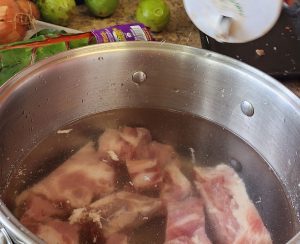
Place meat into boiling water.
Meat
- Rinse and prepare your meat. If you use pork bones, no preparation is needed. If you use pork back ribs, cut into individual ribs. If you use pork butt, cut it into chunks. If you use silver-side or corned beef, leave it whole. Slow cook your meat. Salt well (except the corned beef) I like my meat tender but still firm when cut, so 1 and a half to 2 hours is usually good for me. Other whānau prefer their meat to slow cook for hours until the meat falls off the bone, so it’s a personal preference.
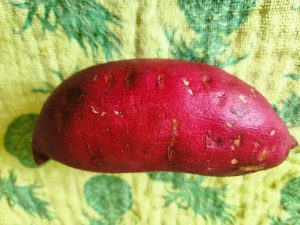
Kumara is a type of sweet potato with a dark red skin that is white on the inside.
Root Vegetables
- Many whānau cook them together with the meat so the flavors fuse together. Some whānau cook them together in a separate pot so they don’t get mushed up. I do both. Try different ways and see what works for you.
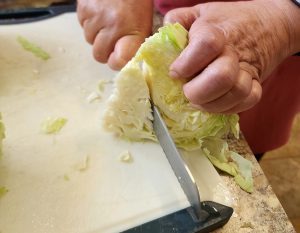
Cut cabbage into wedges. Slice the core out of each section

Break the cabbage into small ‘chunks’ before adding to the pot.
Greens
- About 20 mins to half an hour before the meat is done …. add your greens first, and then place your doughboys on top of the greens.
Note: Like my Mum I sometimes take the meat out before adding the greens. This would depend on the size of the pot, or if I don’t want the meat cooked any more, but then I would return the meat once everything else is cooked. Once again, do what works for you.
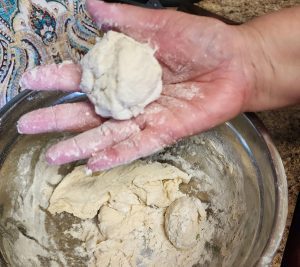
Roll the dough into a ‘log’ shape, then pinch off an approximately 2″ section and lightly shape it, if needed.
Doughboys
Add flour to mixing bowl.
Add water.
Use a spoon to stir water into flour until it begins to form. Wash, dry and then flour your hands. Continue mixing with your hands until it forms soft dough, but be careful not to over mix. Add more flour if needed, but the less you handle it the better. Squeeze dough between your thumb and fore-finger to make small to medium size ‘dumplings’.
Note: Make your doughboys just before you put your greens in so they will be ready to add.

After you bring the water to a boil and add your ingredients, keep the lids slightly ‘cocked’ so that steam can escape.
Finishing Up
When the doughboys are cooked, everything else will be cooked too. Turn your pot off.
Note: I usually just leave it in the pot and everyone serves themselves from there, but sometimes I also dish everything up into serving dishes.

This version includes beef short ribs that we actually baked beforehand and added to the top when ready to serve. Don’t forget to add any meat drippings to the broth just before adding the doughboys.

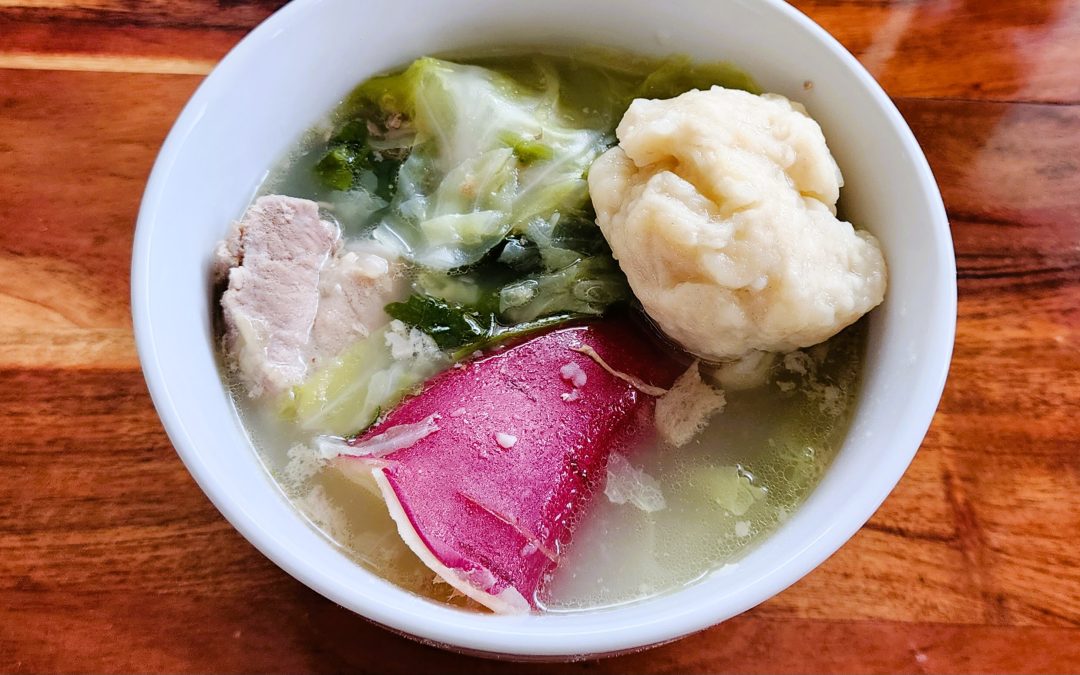
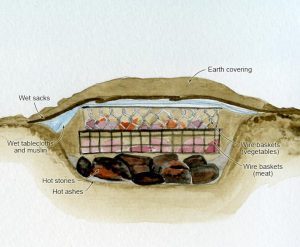
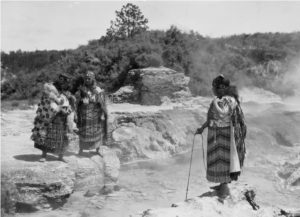
Recent Comments